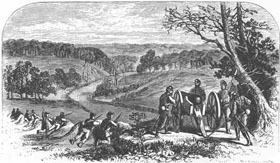1 killed, 24 wounded, 16 missing 65 killed Result Union victory | Date 1 July 1862 | |
 | ||
Similar American Civil War, Battle of Brice's Crossroads, Battle of Iuka, Siege of Corinth, Second Battle of Corinth | ||
Battle of booneville top 7 facts
The Battle of Booneville was fought on July 1, 1862, in Booneville, Mississippi, during the American Civil War. It occurred in the aftermath of the Union victory at the Battle of Shiloh and within the context of Confederate General Braxton Bragg's efforts to recapture the rail junction at Corinth, Mississippi, 20 miles (32 km) north of Booneville.
After the Union Army victory at Shiloh, Maj. Gen. Henry W. Halleck moved his forces slowly toward Corinth, an important rail center. By May 25, 1862, after traveling 5 miles (8.0 km) in three weeks, Halleck was positioned to lay siege to the town. But on May 29, the Confederate forces under General P.G.T. Beauregard slipped away undetected and moved toward Tupelo, Mississippi. In late June, Halleck ordered his forces south and learned that the Confederates, by then under Bragg, were advancing toward Corinth. The 31-year-old Union Col. Philip Sheridan established a fortified position to the south at Booneville on June 28 to await the Confederate attack.
Lead elements of 4,700 troops under the Confederate Brig. Gen. James R. Chalmers, who was also 31 years old, encountered Sheridan's pickets on the morning of July 1, three and 1.8 miles (2.9 km) to the southwest of Corinth. The pickets fell back and established a sound defensive line at the intersection of the roads from Tupelo and Saltillo. Aided by the superiority of their new Colt revolving rifles, the line withstood the initial Confederate assault before withdrawing to a backup position 2 miles (3.2 km) closer to the town.
Chalmers' effort to turn the left flank of this new line was thwarted when Sheridan's main force joined the battle. The bulk of the Union force stayed on the defensive while Sheridan sent the 2nd Michigan Cavalry under Capt. Russell Alexander and the 2nd Iowa Cavalry under Lt. Col. Edward Hatch to attack the Confederate rear and left flank, respectively. The cavalry forces pushed Chalmers to retreat and Sheridan called off the pursuit after 4 miles (6.4 km), when his fatigued troops encountered swampy terrain.
Sheridan estimated that Chalmer lost 65 troops killed in the battle; Federal casualties were one dead, 24 wounded, and 16 missing. Due to the battle, Bragg delayed his offensive strategy for Corinth, allowing Halleck additional time to unite his troops.
